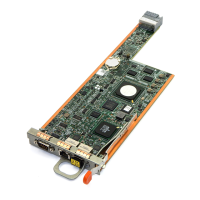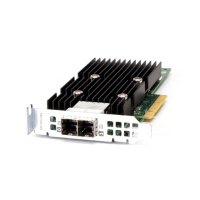Option Description
The options available are Maximum data rate, 10.4 GT/s, and 9.6 GT/s. This option is set to Maximum data rate
by default.
Maximum data rate indicates that the BIOS runs the communication links at the maximum frequency supported by
the processors. You can also select specic frequencies that the processors support, which can vary.
For best performance, you should select Maximum data rate. Any reduction in the communication link frequency
aects the performance of non-local memory accesses and cache coherency trac. In addition, it can slow access
to non-local I/O devices from a particular CPU.
However, if power saving considerations outweigh performance, you might want to reduce the frequency of the
CPU communication links. If you do this, you should localize memory and I/O accesses to the nearest NUMA node
to minimize the impact to system performance.
Virtualization
Technology
Enables or disables the virtualization technology for the processor. This option is set to Enabled by default.
Adjacent Cache
Line Prefetch
Optimizes the system for applications that need high utilization of sequential memory access. This option is set to
Enabled by default. You can disable this option for applications that need high utilization of random memory
access.
Hardware
Prefetcher
Enables or disables the hardware prefetcher. This option is set to Enabled by default.
DCU Streamer
Prefetcher
Enables or disables the Data Cache Unit (DCU) streamer prefetcher. This option is set to Enabled by default.
DCU IP Prefetcher Enables or disables the Data Cache Unit (DCU) IP prefetcher. This option is set to Enabled by default.
Sub NUMA Cluster Enables or disables the Sub NUMA Cluster. This option is set to EnabledDisabled by default.
UPI Prefetch Enables you to get the memory read started early on DDR bus. The Ultra Path Interconnect (UPI) Rx path will
spawn the speculative memory read to Integrated Memory Controller (iMC) directly. This option is set to Enabled
by default.
Logical Processor
Idling
Enables you to improve the energy eciency of a system. It uses the operating system core parking algorithm and
parks some of the logical processors in the system which in turn allows the corresponding processor cores to
transition into a lower power idle state. This option can only be enabled if the operating system supports it. It is set
to Disabled by default.
Congurable TDP Enables you to recongure the processor Thermal Design Power (TDP) levels during POST based on the power
and thermal delivery capabilities of the system. TDP veries the maximum heat the cooling system is needed to
dissipate. This option is set to Nominal by default.
NOTE: This option is only available on certain stock keeping units (SKUs) of the processors.
x2APIC Mode Enables or disables the x2APIC mode. This option is set to Disabled by default.
Dell Controlled
Turbo
Controls the turbo engagement. Enable this option only when System Prole is set to .
NOTE: Depending on the number of installed CPUs, there might be up to four processor listings.
Number of Cores
per Processor
Controls the number of enabled cores in each processor. This option is set to All by default.
Processor 64-bit
Support
Species if the processors support 64-bit extensions.
Processor Core
Speed
Species the maximum core frequency of the processor.
Process Bus Speed Displays the bus speed of the processor.
Pre-operating system management applications 29

